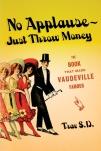New Yorkers will be quick to tell you: one of the most ubiquitous of all variety venues is…right over there. Singers, musicians, clowns, jugglers, and acrobats who perform for spare change on the sidewalk or subway platform, or out on the plaza. Not surpisingly, this is one of the oldest ways of bringing entertainment to the people, going back at least to Medieval times, when local laws forbade theatrical entertainments, forcing performers to be itinerant. Strolling players would hit the fairgrounds and marketplaces, often at the time of festivals, when authorities relaxed control somewhat.
And so on, throughout the centuries. In the U.S., many of America’s seminal entertainers got their first experience performing in the streets: from Master Juba, inventor of the tap dance, clogging for coppers on the streets of Five Points; to young Nathan Birnbaum (later to name himself George Burns) singing on the sidewalks of the Lower East Side; to a young English acrobat named Archibald Leach (soon to become Cary Grant) stilt-walking on the boardwalks of Coney Island.
Many of today’s vaudevillians have taken the same route. To those with a knack for it, it can be surprisingly lucrative. A good busker can clear hundreds of dollars a day. Not to mention the exposure. Personally, I use them as scouting opportunities, and make careful note of the acts I spot playing the streets and subways whom I’d like to present. For the record, there’s a huge backlog!
To learn more about the variety arts past and present, including busking, consult No Applause, Just Throw Money: The Book That Made Vaudeville Famous, available at Amazon, Barnes and Noble, and wherever nutty books are sold.


![Organ_grinder_with_monkey[1]](https://travsd.files.wordpress.com/2011/08/organ_grinder_with_monkey1.jpg?w=225&h=300)